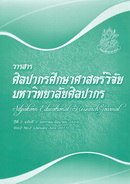โครงร่างความถี่ของคำศัพท์ที่ใช้ในการวัดความยากของบทอ่าน
Main Article Content
Abstract
บทคัดย่อ
งานวิจัยนี้มีวัตถุประสงค์เพื่อศึกษาความเที่ยงตรงเฉพาะหน้าและความเที่ยงตรงตามสภาพของโครงร่างความถี่ของคำศัพท์ที่ใช้ในการวัดความยากของบทอ่านเชิงขยายความ กลุ่มตัวอย่างมี 2 กลุ่ม คือ 1) นักศึกษาในระดับมหาวิทยาลัยในประเทศไทย 3 คน และอาจารย์ในมหาวิทยาลัย 3 คน ซึ่งให้ข้อมูลเกี่ยวกับความเที่ยงตรงเฉพาะหน้า และ 2) นักศึกษาในมหาวิทยาลัย 45 คน และอาจารย์ในมหาวิทยาลัย 5 คน ซึ่งให้ข้อมูลเกี่ยวกับความเที่ยงตรงตามสภาพ เครื่องมือที่ใช้ คือ คอมพิวเตอร์ซอฟต์แวร์ที่เรียกว่าเรนจ์ บทอ่านจำนวน 4 เรื่อง และแบบสอบถาม 2 ฉบับ วิเคราะห์ข้อมูลโดยใช้ ความถี่ สัมประสิทธิ์สหสัมพันธ์แบบเสปียร์แมน และสัมประสิทธิ์สหสัมพันธ์แบบเพียร์สัน ผลการวิจัยพบว่าผู้เข้าร่วมการหาความเที่ยงตรงเฉพาะหน้าจำนวนเพียง 2 จาก 6 คน (คิดเป็นร้อยละ 33.33) คิดว่าโครงร่างความถี่ของคำศัพท์น่าจะเป็นตัวชี้วัดของความยากของบทอ่านที่ดี แต่จากการศึกษาความเที่ยงตรงตามสภาพ พบว่ามีความเป็นไปได้ถึง 76% ที่โครงร่างความถี่ของคำศัพท์มีความเที่ยงตรงตามสภาพเหมือนกับสูตรวัดความยากง่ายของเฟล็ช และมีความเป็นไปได้ถึง 98% ที่โครงร่างความถี่ของคำศัพท์มีความเที่ยงตรงตามสภาพเช่นเดียวกับสูตรวัดความยากง่ายของเฟล็ช-คินเคิด
คำสำคัญ : โครงร่างความถี่ของคำศัพท์ ความยากของบทอ่าน ความเที่ยงตรงเฉพาะหน้า ความเที่ยงตรงตามสภาพ
Abstract
This study aimed to investigate the face validity and concurrent validity of Lexical Frequency Profile (LFP) as an indicator of difficulty of expository texts. There were two groups of participants: 1) three Thai students and three Thai lecturers taking part in the investigation of face validity of LFP and 2) forty-five university students and five lecturers participating in the investigation of concurrent validity. The instruments were 1) computer software called RANGE, 2) four reading passages and 3) two questionnaires. The data were analyzed by frequency, Speaman’s rho and Pearson r. The results revealed that only two out of six participants (33.33%) taking part in the investigation of face validity agreed that LFP looked good as an indicator of text difficulty. On the other hand, the investigation of concurrent validity showed that there was a 76 percent possibility that the extent that the use of LFP to indicate text difficulty was asconcurrently valid as Flesch readability formula, and there was a 98 percent possibility that the indication of text difficulty by LFP was as concurrently valid as Flesch-Kincaid readability test.
Keywords: Lexical Frequency Profile (LFP), text difficulty, face validity, concurrent validity

